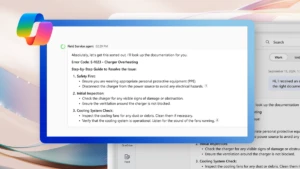
Reduce development times and increase ROI with Microsoft Power Platform
In today’s digital era, organizations need to maximize IT and business team efforts for process improvements and complex challenges. With cost and ROI in focus, Microsoft Power Platform offers low-code tools that enable efficient enterprise-grade solutions.
To support investment decisions, Microsoft commissioned a 2024 Forrester Total Economic Impact™ study that quantified Power Platform’s impact. The study highlights a 224% ROI, USD82 million in net-present value (NPV), and a payback period of under six months. These benefits stem from reduced development timelines and IT costs, time savings for users, and faster revenue growth from quicker solution deployment.

The even better news: these figures don’t account yet for the transformational capabilities of generative AI. Currently, Microsoft is seeing organizations create workflow automations two times faster and developers successfully build low-code applications at a 60% higher success rate.

The Total Economic Impact™ of Microsoft Power Platform
Explore the cost savings, efficiency gains, and revenue growth that organizations experienced using Microsoft Power Platform.
Over time, we expect time savings for users and developers, IT costs savings, and topline revenue growth to dramatically increase as generative AI matures.
For now, we encourage you to learn how customers are maximizing their current low-code investments below—and learn how you can do the same.
Accelerate development timelines by 35% with low-code

Microsoft Power Platform has enabled organizations to significantly reduce development and IT costs by significantly streamlining the creation of solutions and automations.
By combining traditional development environments with Microsoft Power Platform’s low-code tools, companies have accelerated their development processes by 35%, allowing them to bring new solutions to market faster and with fewer resources.
This efficiency gain, combined with the ability to replace costly legacy tech stacks, has resulted in substantial savings. For example, the Forrester study found that the composite organization was able to reduce their tech stack expenses by up to 80% within three years and cut support staff by up to nine full-time employees.
Time isn’t the only thing enterprises are saving by investing in low code tools for developers. Companies like G&J Pepsi-Cola Bottlers, who was not interviewed for the Forrester study, used Microsoft Power Platform to achieve over USD1.5 million in savings by streamlining development and reducing costs. Their IT team quickly built apps like a Store Audit app that saved USD100,000 in external development costs and a Parking Lot app developed in one day, saving drivers time and reducing delivery costs.
The Forrester study found that the composite organization achieved a risk-adjusted total of USD43.6 million in direct development and IT cost savings over three years, demonstrating Microsoft Power Platform’s powerful impact on operational efficiency and cost reduction.
Complete tasks 25% faster with Microsoft Power Platform

Microsoft Power Platform has proven to be a transformative tool for organizations, enabling significant time savings and increased productivity across various departments. By building solutions with low-code products such as Microsoft Power Apps, Microsoft Power Automate, and Microsoft Power Pages, organizations have streamlined processes that took weeks, now completing them in hours or minutes.
For instance, one energy customer Forrester spoke to reported savings of USD1 million, with a third of that coming directly from employee time savings. In another case, a financial services firm reduced an up-to-six-week manual HR process to just one hour, freeing up resources for more strategic initiatives.
Additionally, while they were not interviewed for this particular TEI study, EY separately reported that they used Microsoft Power Platform to create PowerMatch, an app that increased automatic payment clearing rates in their SAP system from 30% to 80% and improved matched payments to 95%. PowerMatch is set to save EY 230,000 hours annually, illustrating the time saving capabilities of low-code solutions.
On average, organizations have seen a 25% reduction for users in the time required to complete key processes improved using Microsoft Power Platform, translating into a risk-adjusted total of USD44.4 million in time savings over three years. This efficiency not only drives operational improvements, but also empowers teams to focus on innovation and value creation.
Revenue increased by 7% by empowering employees

Microsoft Power Platform has proven to be a catalyst for topline revenue growth by notably improving the time to market for new solutions, enabling organizations to better meet customer needs and capitalize on market opportunities.
By rapidly building and iterating on prototypes, businesses have swiftly adapted to client feedback, enhancing user experience and maintaining competitive market share. For example, companies using Microsoft Power Platform have seen up to 7% of their revenue growth directly attributable to these accelerated processes, resulting in a risk-adjusted total of USD15.4 million in additional revenue over three years.
This capacity to quickly deliver tailored solutions not only strengthens customer loyalty but also drives net new business, contributing to substantial revenue increases across impacted areas.
For example, one head of new product at a manufacturing organization said, “By being able to deliver the right product to the customer, we’re getting additional orders from repeat customers. We avoid churn because customers are not going to competitors. We’re getting net new customers. For certain parts of our organization, our revenue increased by 18% to 20%, split between net new customers and repeat customers.”
Customers such as Lerøy Seafood Group, who was not interviewed for this TEI study, separately shared they used Microsoft Power Platform to streamline operations and drive millions in savings annually—contributing to topline revenue. Key innovations that drove savings and revenue increases included apps that optimized production schedules and improved fish weight estimation accuracy, to the tune of USD8 million annually.
Get a custom business value assessment today
And the implementation of Microsoft Power Platform goes beyond quantifiable benefits, offering organizations a robust foundation for future growth, improved governance, and enhanced employee satisfaction.
Organizations are reporting reduced risks of shadow IT by empowering employees to solve problems with low-code tools and governance via embedded tools such as Managed Environments. This not only strengthens compliance and security, but also leads to a more engaged and satisfied workforce.
As businesses continue to explore new opportunities, the flexibility and scalability of Microsoft Power Platform position it as a key enabler of digital transformation, driving long-term success and sustainable growth in an increasingly competitive market.
We invite you to read the Forrester Total Economic Impact of Microsoft Power Platform report and sign up for a custom business value assessment with your Microsoft Power Platform specialist.




